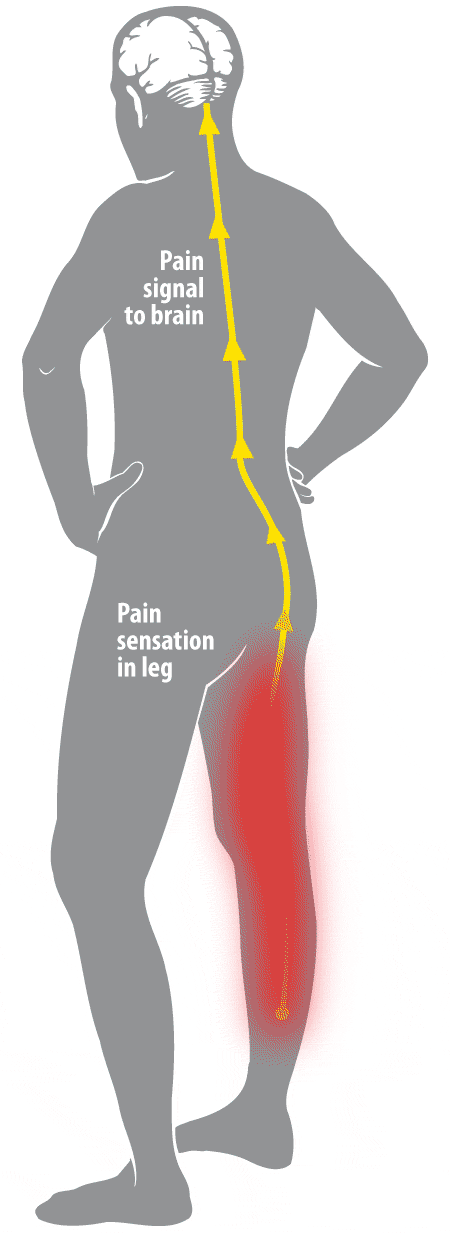Nerve Pain
Nerve damage or nerve impingement is a common cause for leg pain. Damage to the peripheral nerves is called Peripheral Neuropathy. Leg pain may also be associated with degeneration of the spine, causing inflammation of the nerves affecting the legs. A common cause of leg pain while standing and walking is Neurogenic Claudication. Click on the links below to learn more about these conditions and treatments we offer.
Peripheral Neuropathy
Peripheral neuropathy is a result of damage to your peripheral nerves. This can often cause weakness, numbness and worst of all pain. It can also affect other areas of your body, most commonly feet and hands. The most common cause of peripheral neuropathy is Diabetes. Traditional first line treatments include oral mediations. But what happens when these medications stop working or their side effects inhibit your life, such as dizziness, drowsiness, weakness, and fatigue? How about nerve stimulation?
Causes of Peripheral Neuropathy
-
Diabetes Mellitus
-
Traumatic injuries,
-
Infections,
-
Metabolic problems,
-
Inherited causes
-
Exposure to toxins
Symptoms of Peripheral Neuropathy
-
Gradual onset of numbness, prickling or tingling in your feet or hands, which can spread upward into your legs and arms
-
Sharp, jabbing, throbbing, freezing or burning pain
-
Extreme sensitivity to touch
-
Lack of coordination and falling
-
Muscle weakness or paralysis if motor nerves are affected
Spinal cord stimulation has been used for the relief of chronic, intractable pain for over 2 decades. Spinal Cord Stimulator (SCS) systems work by interrupting pain signal before they reach the brain to help you manage your pain and lead a fuller life. The goal for spinal cord stimulation is a 50-70% reduction in pain.
The procedure initially involves a trial or temporary placement of stimulation leads for up to one week to determine if the patient will receive adequate pain relief prior to undergoing permanent placement. This is one of the few times a patient can take a test drive prior to a procedure. If the patient receives significant relief and wants to move forward with permanent placement, the procedure is performed approximately 2-4 weeks later.
SCS procedure is an outpatient procedure which takes approximately 20 minutes for the initial trial procedure and 45 minutes for permanent placement. While receiving light sedation, the areas of your back and buttock are prepped where the leads and generator are to be placed. Local anesthetic will be used to numb the incisions. The electrode leads are inserted with the aid of fluoroscopy into the epidural space. The leads are connected to a small generator/battery that is placed under the skin overlying the buttocks. This is similar to placement of a pacemaker in the chest. The patient is then watched in the holding area for 30-60 minutes and discharged home.


Neurogenic Claudication

Neurogenic = arising in the nervous system, Claudication= leg pain, heaviness and/or weakness with walking.
Neurogenic claudication results from compression of the spinal nerves in the lumbar (lower) spine. It is sometimes known as pseudoclaudication. It differs from vascular claudication, sometimes simply called claudication, which is caused by impaired blood flow to the leg muscles.
Symptoms of Neurogenic Claudication
Causes of Neurogenic Claudication
-
pain, tingling, or cramping in one or both legs, hips, and buttocks.
-
Weakness or heaviness in the legs.
-
Symptoms are especially present when standing upright or walking
-
Symptoms usually relieved with leaning forward or sitting down.
-
Bone spurs
-
Bulging discs
-
Herniated discs
-
Facet joint cysts
-
Spondylolisthesis
-
Arthritis of the spine

Learn about the newest minimally invasive treatment to relieve your leg pain without undergoing spine surgery, called Vertiflex Superion!
After undergoing conservative management, which typically includes oral medication and steroid injections of the spine, the patient may be a candidate for the procedure. Imaging, including X-rays and MRI of the spine, will be obtained, if not previously done so. Imaging helps determine if the underlying cause is Lumbar Stenosis. The imaging will be reviewed to determine if the patient is a candidate for the procedure.
Who is a candidate?
What is Lumbar Stenosis?
Lumbar Spinal Stenosis is caused by changes in the shape and size of the spinal canal as we age. This natural degenerative process can cause anatomical changes at any time, but is most common in people over 50 years and may continue to progress with age.
How does Superion Work?
Superion is a completely new, minimally invasive approach to treating lumbar stenosis that fills a gap in the continuum between conservative care and invasive surgery. Designed with patient safety and comfort in mind, Superion is implanted through a small tube the size of a dime to reduce tissue damage and blood loss. It’s a simple outpatient procedure with a rapid recovery time and no destabilization of the spine.
Indirect Decompression
The Superion implant acts as an indirect decompression device. Its anatomic design provides optimal fit and preserves a patient’s anatomy and ability to maintain motion. Superion acts as an extension blocker, relieving pressure on the affected nerves in the manner that one would achieve relief in a seated or flexed position. Available in multiple sizes to accommodate varying patient anatomy, Superion ensures controlled movement and minimizes post-procedure complications. Superion was developed to provide patients with a safe and effective alternative when conservative treatment has failed and laminectomy is too aggressive.


